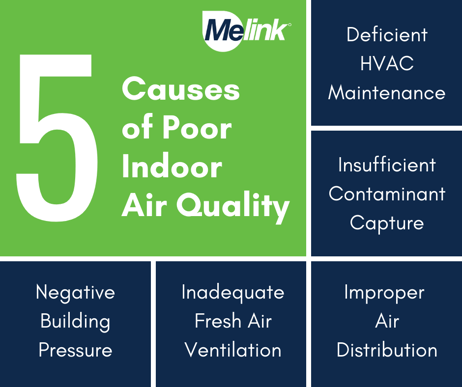Indoor Air Quality (IAQ), or the condition of the air inside a building, is a very important building health attribute that can affect the comfort, productivity, and wellness of a facility's occupants, workers, students, and visitors.
Poor IAQ has been linked to several symptoms such as headaches, fatigue, trouble concentrating, and dizziness, as well as irritation of the eyes, nose, throat, and lungs. The more prolonged the exposure, the greater the effect. Here are five common factors that contribute to poor IAQ:

Negative Building Pressure – A negative building, one in which the pressure inside is less than the pressure outside, will draw air through doors, windows, and any other openings in the exterior. This air is unfiltered and unconditioned, so whatever is outside comes inside, including high humidity, pollutants, insects, and so on.
Inadequate Fresh Air Ventilation – Fresh outside air is introduced into a building through a series of fans and dampers. Relief air is also evacuated from a building in a similar manner. These air systems must be properly set up and adjusted for the correct amount of fresh air needed for the building based on its use and occupancy.
Insufficient Contaminant Capture – Contaminants that are produced from various operations within a building, such as heat and smoke from cooking, steam from dishwashing, or pollutants from work processes, are captured and contained with systems of fans and canopies. These systems must be properly configured and adjusted for each unique process in order to capture and contain the effluent produced.
Improper Air Distribution – The various spaces within a building have their own ventilation and pressurization needs, so the air movement inside a building is vital. The air distribution systems must be properly configured and adjusted throughout the entire building.
Deficient HVAC Maintenance – The various fans, dampers, filters, coils, and other devices comprising a Heating, Ventilating, and Air Conditioning (HVAC) system must be cared for, and maintained correctly and frequently in order to support proper indoor air quality.
